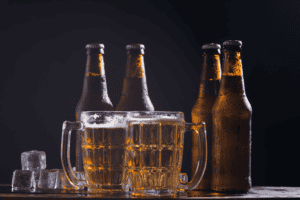Alcoholism, also known as alcohol use disorder (AUD), is a chronic disease characterized by a pattern of excessive alcohol use despite negative consequences.
Alcohol abuse can result in a range of negative consequences for individuals and their loved ones, making it essential to recognize the signs and symptoms. Some common indicators of alcohol abuse include regularly drinking to excess or binge drinking, neglecting responsibilities at work, school, or home and drinking alone or in secret.
Increased tolerance to alcohol, withdrawal symptoms when abstaining from alcohol, difficulties limiting alcohol consumption, and drinking in inappropriate or risky contexts are further warning signals.
Drinking Excessive Amounts of Alcohol
Excessive drinking can lead to Alcohol Binge Drinking which have a wide range of negative consequences that impact a person’s physical, mental, and emotional health. These consequences include an increased risk of accidents, injuries, and violence due to impaired judgment and reaction times.
Additionally, it can lead to several health problems, such as liver disease, heart disease, high blood pressure, cancer, and pancreatitis. Dependence and addiction are also potential outcomes of excessive drinking, which often require professional help to overcome.
Alcohol abuse begins cognitive impairment, mental health problems such as depression and anxiety, relationship problems, and legal issues such as DUI charges, public intoxication, and disorderly conduct. It’s crucial to recognize the harmful effects of excessive alcohol drinking and to limit alcohol intake to safe levels.
How Common is Alcoholism? (The Statistics)
Alcoholism & alcoholism Alcohol abuse, also known as alcohol use disorder (AUD), is a widespread problem that affects millions of people around the world. Here are some statistics on the prevalence of alcoholism:
- According to the World Health Organization (WHO), about 3 million people die each year worldwide as a result of harmful use of alcohol.
- In the United States, an estimated 14.5 million adults (ages 18 and older) had alcohol use disorder in 2019, according to the National Survey on Drug Use and Health (NSDUH). This represents 5.8% of the adult population.
- The same NSDUH survey found that 25.8% of people ages 18 and older reported binge drinking in the past month, and 6.3% reported heavy alcohol use in the past month.
- Men are more likely than women to have alcohol use disorder. In the United States, 7.5% of adult men had alcohol use disorder in 2019, compared to 4.2% of adult women (American National Institute)
- Alcohol use disorder is also more common among young adults. In the United States, 14.5% of adults ages 18-25 had alcohol use disorder in 2019, compared to 6.3% of adults ages 26 and older.(American National Institute)
It’s important to note that these statistics are based on self-reported data, and the actual prevalence of alcoholism may be higher due to underreporting.
Signs & Symptoms of Alcoholism
Despite what movies and television shows portray, it’s not always easy to tell if someone has a problem with drinking. A person with substance use disorder might not hang out in a bar all day or fall down after they’ve been drinking heavily. Despite their alcohol addiction, some people seem fine and productive in their daily lives.
One of the early signs is a pattern of excessive drinking. This pattern includes both binge drinking and heavy drinking. BD is when someone drinks a large amount at one time. It is having five or more drinks in less than two hours for men. For women, it is having four or more drinks within two hours. Heavy drinking is 8 or more drinks a week for women and 15 or more drinks a week for men.
Drinking alcohol excessively from time to time does not mean someone has an alcohol addiction but it does put them at a higher risk for developing it.
Physical Signs of Alcoholism
Alcohol addiction or drug abuse can have a range of physical side effects or warning signs that can seriously impact a person’s health and well-being. These side effects can include the smell of alcohol on the breath, weight loss, dry skin and brittle hair and nails. Moreover, you might notice signs such as yellow eyes and skin due to liver damage, and poor hygiene.
The deadly effects of alcohol on the body are increased risk of high blood pressure, heart disease, certain types of cancer, weakened immune system, and nutritional deficiencies. Seeking addiction treatment and support for alcohol addiction is crucial to addressing these warning signs and improving overall health and quality of life.
Behavioral Signs of Alcohol Misuse
Alcohol misuse can have some behavioral symptoms as well. Common behavioral symptoms of alcohol include drinking more than intended, difficulty controlling the amount of alcohol consumed, spending a lot of time drinking or recovering from the effects of alcohol, and giving up enjoyable activities to drink.
Moreover, there can be signs of continuing to drink despite negative consequences such as job loss or relationship problems, driving under the influence of alcohol, and experiencing memory loss or blackouts after drinking. These warning signs should be considered serious and addressed immediately. If you or someone you know is experiencing any of these symptoms, it may be indicative of an alcohol use disorder, and it is important to seek help and support to address the issue. To learn more about the treatment options please reach out to our team.
Mental and Emotional Symptoms of Alcoholism
Heavy drinking and alcohol addiction can have numerous mental and emotional side effects. These can include depression, anxiety, irritability, and mood swings. Additionally, a person may experience difficulty concentrating, memory problems, decreased motivation, and withdrawal from social activities are common.
Individuals struggling with severe alcohol addiction may also experience denial of the problem and have suicidal thoughts or attempts. These symptoms can severely impact an individual’s personal and professional life, and it is important to seek proper treatment from a medical professional or mental health professional if experiencing any of these symptoms.
Persistent Alcohol Use Despite Awareness of Issues
Persistent alcohol use despite awareness of issues refers to a pattern of behavior where an individual continues to drink alcohol despite being aware of the negative consequences that it may cause.
These negative consequences can include physical problems, social and relationship problems, financial issues, legal troubles, and psychological issues such as depression and anxiety.
Persistent alcohol use despite awareness of issues is a common characteristic of alcohol use disorders. Individuals who engage in this behavior often struggle with controlling their alcohol intake and may experience cravings and withdrawal symptoms when they try to stop or cut down.
Increased Alcohol Tolerance
Alcohol tolerance refers to a person’s ability to handle the effects of alcohol, such as reduced motor skills and impaired judgment. Increased tolerance to alcohol can occur due to a combination of genetic, environmental, and behavioral factors.
Some individuals may have a genetic predisposition to process alcohol more efficiently, while others may develop a tolerance through regular and/or heavy drinking.
Behaviors such as drinking on an empty stomach, pacing drinks, and having a higher body weight may also contribute to an increased tolerance to alcohol. It is important to note that even with an increased tolerance, excessive alcohol consumption can still lead to serious health risks.
Experiencing Withdrawal Symptoms
Alcoholism is a condition that can develop when a person who has been drinking heavily abruptly stops or reduces their alcohol intake, and experiencing withdrawal symptoms is a classic warning sign of alcoholism. Withdrawal symptoms can be physical or emotional and can include tremors, sweating, nausea, anxiety, agitation, and seizures.
Alcoholism withdrawal is caused by changes in the brain and body that occur as a result of prolonged and heavy alcohol use. These changes can make it difficult for a person to stop or reduce their drinking without experiencing unpleasant or dangerous symptoms.
Other Signs of Alcohol Abuse
Aside from physical and psychological symptoms, individuals who struggle with alcohol abuse may experience other negative outcomes. These can include legal problems like getting arrested for alcohol-related offenses, and financial issues such as overspending on alcohol or losing employment due to drinking.
There can be also relationship difficulties such as arguments or domestic violence, social isolation where they withdraw from friends and family, engaging in risky behaviors like driving under the influence or having unprotected sex and poor performance at work or school.
It’s important to note that the severity of these problems may vary depending on the individual’s circumstances, and seeking help is crucial to overcome alcohol abuse.
The Prevalence of Alcohol Misuse and Drunk Driving
Alcohol misuse and drunk driving are significant public health concerns with significant prevalence worldwide.
Alcohol misuse, which includes heavy drinking, binge drinking, and alcohol use disorder, is a common problem globally. According to the World Health Organization (WHO), the harmful use of alcohol is responsible for approximately 3 million deaths each year, which accounts for 5.3% of all deaths worldwide. In the United States, an estimated 14.5 million adults aged 18 and older had alcohol use disorder in 2019, according to the National Survey on Drug Use and Health (NSDUH).
Drunk driving, or driving under the influence (DUI) of alcohol, is also a serious problem with significant prevalence. According to the WHO, alcohol-related crashes are responsible for approximately 20% of all road traffic deaths worldwide. In the United States, the Centers for Disease Control and Prevention (CDC) reports that in 2019, 10,142 people died in alcohol-impaired driving crashes, accounting for 28% of all traffic-related deaths in the country.
How Do the Psychological and Physical Components of AUDs Relate To One Another?
Alcohol Use Disorders (AUDs) have both psychological and physical components. The psychological component refers to the mental and emotional aspects of addiction, such as the cravings for alcohol and the compulsion to drink. The physical component refers to the changes that occur in the body as a result of chronic and heavy alcohol use.
The psychological and physical components of AUDs are closely intertwined. For example, the physical changes in the brain that occur as a result of chronic and heavy alcohol use can lead to psychological symptoms such as cravings and compulsion to drink. In turn, these psychological symptoms can drive a person to drink more, leading to further physical changes in the body.
Over time, the physical and psychological components of AUDs can reinforce each other, leading to a cycle of addiction that is difficult to break. This cycle can result in a range of negative health and social consequences, including physical dependence on alcohol, liver disease, relationship problems, and legal issues.
Treating AUDs requires addressing both the psychological and physical components of addiction. This may involve a combination of medication, counseling, and behavioral therapies to address both the physical changes in the body and the psychological symptoms of addiction. By treating both components of AUDs, individuals with addiction can achieve long-term recovery and improve their overall quality of life.
Physical Changes and Issues As a Result of Giving Up On Alcoholism
It’s important to recognize that giving up alcohol after a period of heavy or prolonged use can result in physical changes and issues. These changes can occur as the body adjusts to functioning without the presence of alcohol, and can vary in severity depending on the length and severity of the person’s alcohol use.
Some common physical changes that may occur when a person stops drinking alcohol include:
- Withdrawal symptoms: As mentioned earlier, withdrawal symptoms can occur when a person stops drinking after a period of heavy or prolonged use. These symptoms can include tremors, sweating, nausea, vomiting, anxiety, and insomnia, among others.
- Increased heart rate and blood pressure: When a person stops drinking, their heart rate and blood pressure may increase as the body adjusts to functioning without alcohol.
- Digestive issues: Heavy alcohol use can cause damage to the digestive system, and quitting alcohol may result in symptoms such as nausea, vomiting, diarrhea, and abdominal pain.
- Skin issues: Alcohol abuse can cause dehydration and inflammation, which can result in skin issues such as dryness, redness, and itching. When a person stops drinking, their skin may initially become drier and more irritated before improving over time.
- Sleep disturbances: Heavy alcohol use can disrupt sleep patterns, and quitting alcohol may result in temporary sleep disturbances such as insomnia or vivid dreams.
If you are experiencing these symptoms or know a person suffering from these signs. It is very important to seek medical attention and professional assistance. For help finding a rehab center near you reach out to our team today.
Finding a Rehab for Alcoholism
Alcohol use disorder can have significant negative impacts on an individual’s physical, mental, and social well-being. Drinking more alcohol than you anticipated, going through withdrawal symptoms when trying to quit, putting off obligations and interests, and continuing to drink despite negative effects are all indications of alcohol misuse or substance abuse.
The symptoms of alcohol-related problems can include blackouts, memory loss, slurred speech, impaired coordination, and mood swings. This blog emphasizes the importance of recognizing these signs and symptoms and seeking help to prevent or address the negative effects of alcohol abuse as it is very necessary to get help for individuals suffering from addiction.
Quit Alcohol is here to help those battling addiction find the treatment center and program that meets their specific needs. Our rehab advisors are available 24 hours a day, 7 days a week to answer your questions and provide the support you need.















